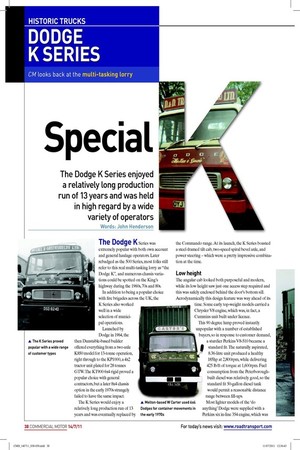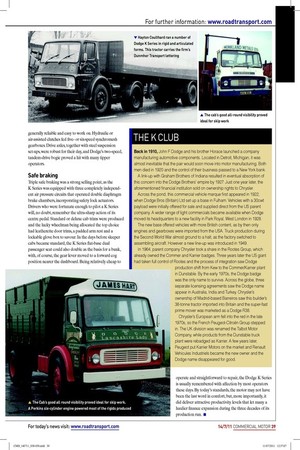Special
Page 32

Page 33

If you've noticed an error in this article please click here to report it so we can fix it.
The Dodge K Series enjoyed a relatively long production run of 13 years and was held in high regard by a wide variety of operators
Words: John Henderson The Dodge K Series was
extremely popular with both own account and general haulage operators. Later rebadged as the 500 Series, most folks still refer to this real multi-tasking lorry as “the Dodge K”, and numerous chassis varia tions could be spotted on the King’s highway during the 1960s, 70s and 80s.
In addition to being a popular choice with ire brigades across the UK, the K Series also worked well in a wide selection of munici pal operations.
Launched by Dodge in 1964, the then Dunstable-based builder offered everything from a two-axle K850 model for 13-tonne operation, right through to the KP1000, a 4x2 tractor unit plated for 28 tonnes GTW. The KT900 6x4 rigid proved a popular choice with general contractors, but a later 8x4 chassis option in the early 1970s strangely failed to have the same impact.
The K Series would enjoy a relatively long production run of 13 years and was eventually replaced by the Commando range. At its launch, the K Series boasted a steel-framed tilt cab, two-speed spiral bevel axle, and power steering – which were a pretty impressive combination at the time.
Low height
The angular cab looked both purposeful and modern, while its low height saw just one access step required and this was safely enclosed behind the door’s bottom sill. Aerodynamically this design feature was way ahead of its time. Some early top-weight models carried a Chrysler V8 engine, which was, in fact, a Cummins unit built under licence.
This 90 degree lump proved instantly unpopular with a number of established buyers, so in response to customer demand, a sturdier Perkins V8-510 became a standard it. The naturally aspirated, 8.36-litre unit produced a healthy 185hp at 2,800rpm, while delivering 425 lb/ft of torque at 1,600rpm. Fuel consumption from the Peterboroughbuilt diesel was relatively good, so the standard it 50-gallon diesel tank would permit a reasonable distance range between ill-ups.
Most lighter models of the ‘do anything’ Dodge were supplied with a Perkins six in-line 354 engine, which was generally reliable and easy to work on. Hydraulic or air-assisted clutches fed iveor six-speed synchromesh gearboxes. Drive axles, together with steel suspension set-ups, were robust for their day, and Dodge’s two-speed, tandem-drive bogie proved a hit with many tipper operators.
Safe braking
Triple safe braking was a strong selling point, as the K Series was equipped with three completely independent air pressure circuits that operated double diaphragm brake chambers, incorporating safety lock actuators. Drivers who were fortunate enough to pilot a K Series will, no doubt, remember the ultra-sharp action of its centre pedal. Standard or deluxe cab trims were produced and the lucky wheelman being allocated the top choice had leatherette door trims, a padded arm rest and a lockable glove box to savour. In the days before sleeper cabs became standard, the K Series lat-base dual passenger seat could also double as the basis for a bunk, with, of course, the gear lever moved to a forward cog position nearer the dashboard. Being relatively cheap to













































